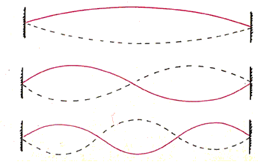How many nodes are on this standing wave? How many wavelengths are on this standing wave? What is the speed of the wave on the string? What is the wavelength of this standing wave? What is the frequency of this standing wave?
A 24.5 cm long string has a mass of 3.5 g and a tension of 8.6 kN. A standing wave of the 4th harmonic is created on the string.
A 24.5 cm long string has a mass of 3.5 g and a tension of 8.6 kN. A standing wave of the 4th harmonic is created on the string.
1 Answer
(a)
(b)
(c)
(d)
(e)
Explanation:
Given
A standing wave of the
Linear density of string
(a). Nodes on this standing wave
For a standing wave on the string, both ends must have have zero displacement, i.e., it is a node.

Above figure shows standing wave of
General formulae for
Number of nodes
Length of the string
(b) No of wavelengths on standing wave.
Number of wavelengths on the string with
(c). Speed of the wave on the string.
It can be obtained from the expression
Wave velocity
or
or
or
(d). Wavelength of this standing wave.
It can be obtained from (b)
Length of string,
(e). frequency of this standing wave can be obtained from the expression
Inserting various values
